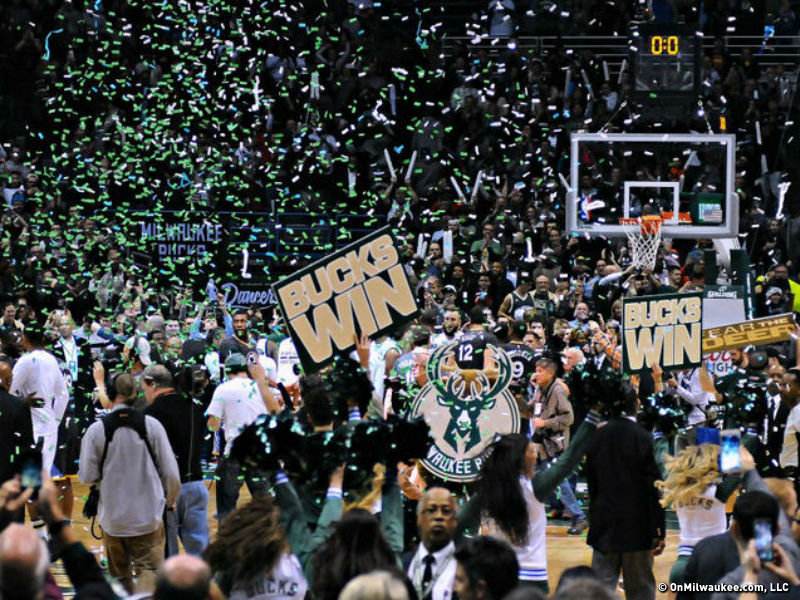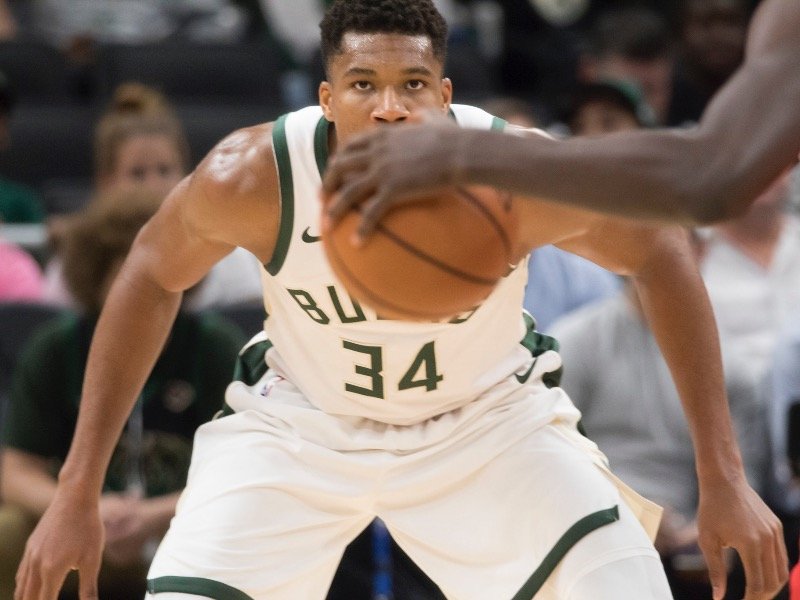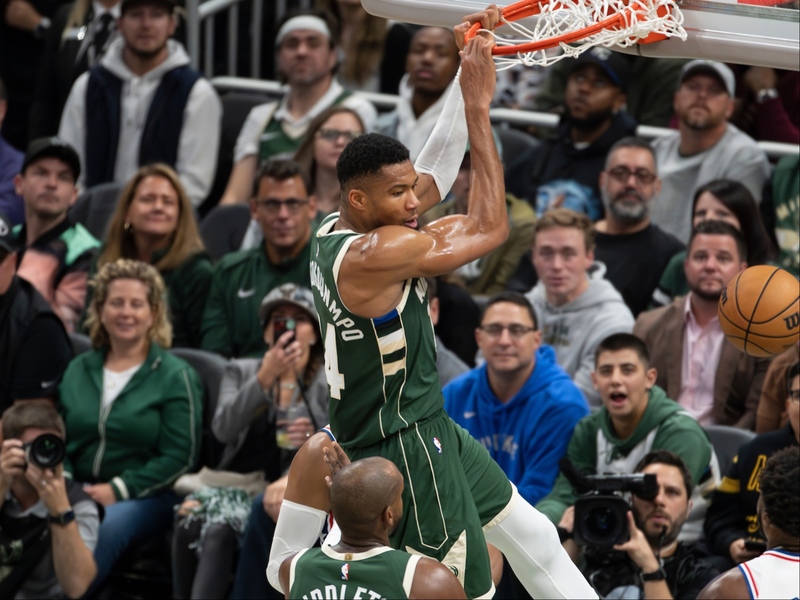The last time the Bucks played at home, the game ended with players hugging, confetti raining from the rafters, "Bucks win!" displayed triumphantly on the jumbotron and a fervent fan section wearing prophetic T-shirts chanting and cheering long after the rest of the arena had emptied of its grinning occupants.
After beating the defending-champion Warriors on Dec. 12, the Bucks were streak-snappers, Goliath-slayers and kings of the basketball world – if only by a loose interpretation of the transitive property. They’d played a nearly perfect game and defeated previously undefeated Golden State in convincing fashion, shocking the Dubs and ending their various winning streaks.
Beforehand, the secondary markets had shown only single seats available and none for less than $100. The Cream City Clash attracted national attention for its ballsy "24-1" shirts predicting the Bucks would hand the Warriors their first loss. The famous Red Panda acrobat put on a mesmerizing halftime show.
"It was electric," said Paul Henning, one of the most publicly visibly fans and leader of the "Save Our Bucks" campaign. "As far as people, it was a true sellout, and there were no empty seats. I haven’t seen anything like it since 2001; I’m pretty confident in that, too. The atmosphere, it hasn’t been like that in 15 years. Everybody was in awe of the experience."
It was a perfect storm of great on-court performance and good off-court publicity – a Saturday-night sellout crowd stirred into rapture with beautiful basketball and the extravagant, Bucks-branded spectacle that accompanies every big event put on by the team. It was without a doubt the franchise’s biggest moment of the year, and perhaps the decade.
"We were part of history tonight," said Ben Fink, the Cream City Clash leader, in the stands immediately after the game. "We had a lot of high hopes going into the season, and this is the type of win that can definitely turn the season around. Super excited, we’ll see what happens."
Cream City Clash prophetic? #Bucks pic.twitter.com/R7GYua4XAV
— Jimmy Carlton (@jimmycarlton88) December 13, 2015
We now know what happened and, 11 days later, Milwaukee returns to the BMO Harris Bradley Center for its first home game since that signature victory. As with most things involving this capricious squad in this up-and-down season, much has changed since then.
Rather than ride the good energy on a four-game Western Conference road trip, the Bucks were listless in a loss to the lowly Lakers, vanquished again in Los Angeles the next night by the Clippers and, in the much-hyped rematch in Golden State, ultimately overpowered by the suddenly-not-trash-talking Warriors after leading for most of the game.
On Sunday, the unpredictable Bucks got a dose of good and then bad news, beating the Suns without forward Giannis Antetokounmpo but learning that head coach Jason Kidd would be sidelined indefinitely due to hip surgery.
Wednesday night, they’re back home to play the league-worst 76ers, undeniably lacking the momentum they’d hoped to gain after the sensational Warriors win. But while interim coach Joe Prunty and an ever-changing rotation of players try to figure out how to be consistent and get more wins, the always-brainstorming and much-ballyhooed business operations staff works to reproduce – promotionally, experientially and entertainment-wise – the success achieved in the lucrative Warriors game. That night saw the second-highest merchandise sales in team history, a top-three taking on food and beverage, and off-the-charts performance on the team’s social media channels.
"What we need to do," said team president Peter Feigin, "is capture that magic in a bottle and replicate it.
But how do the Bucks, fourth-worst in the NBA in average attendance, do that? How do they reproduce the salesmanship, buzz, energy, atmosphere and experiential elements of that Warriors game? And if selling out a potentially history-making game on a Saturday night against the defending champions is the high-water mark, what’s realistic the other 40 home dates per season?
OnMilwaukee spoke to Feigin after the Bucks’ "awesome" win against the Warriors about business, brand and expectations moving forward.
OnMilwaukee: Did you have a pretty good idea that what happened off the court for the Golden State game was going to happen?
Peter Feigin: Yeah, we saw everything trending about a week before, just with where ticket sales were 14 days out indicated it would be a sellout. Then during the week, our Facebook impressions on Dec. 12th and 13th were 300 percent higher than average, our Instagram engagement was up 76 percent for the two days prior and the day after the game, and our total web traffic really rivaled our traffic on the new logo unveil, which was the highest date of traffic.
Secondary markets were crazy. It was, without overemphasizing, the place to be. There was demand, and that demand built up two weeks out in a big way and then was sold out 48 hours prior, which just hasn’t happened before.
OnMilwaukee: Depending what happens the rest of the season, is it possible that game becomes less of a potential game-changer and more of a blip?
Feigin: No, they’re all monumental in building momentum. When you have 19,000 fans in the arena, your casual fans, your engaged fan, your rabid fan, they’re all kind of being affected in such a significant way that it has a great effect. And then you’ve got to understand the strategy on ticket sales, we were able to leverage the game and bundle other games with it on ticket packages, which was very, very strong. So the game not only has an effect on ticket sales and revenue because of Golden State’s success, it will actually have an impact on three or four more games down the road.
People talk a lot about Steph Curry's appeal to kids being as the ordinary, everyman superstar. Never more apparent. pic.twitter.com/Q3Bg6iL42g
— Jimmy Carlton (@jimmycarlton88) December 13, 2015
OnMilwaukee: How do you reproduce the atmosphere and energy in the building that night?
Feigin: Well, what you do is continue – on an operational basis, you debrief and you look for what are things to improve on in game entertainment, in food and bev, in cleanliness, and then you keep it at such a high level. Then you’re able to take a number of fans and engage them on social and on email and kind of get them back in the fold, build the connective tissue with these fans so they actually feel a part of the team.
OnMilwaukee: Your staff has been very successful advertising to and reaching young basketball fans, but how do you engage other, older fans that might be disillusioned or disinterested in the young Bucks and Own the Future?
Feigin: It’s all about targeted and segmented engagement, so different messages for different fans. So you talk about, for instance, the legacy of the team, and bringing back legends that people (ages) 55 to 75 might relate to a little bit more. So what’s it like to have Oscar and Kareem here? What’s it like to think of it all and encapsulate the Bucks as one team and one brand?
And then we also have to be very smart about our communication. How do we communicate to those people? Some of them are face-to-face; millennials are obviously more on social. How do we encourage 6 to 12 year olds that this is the fun, cool place to be? So we’re constantly playing with messaging and engagements and call-to-actions to each of those segment groups to see what works.
OnMilwaukee: At the end of the day, are on-court wins and losses still most important to determining off-court business success?
Feigin: Without question, wins and losses are what differentiate sold-out crowds from OK crowds. I mean, what you want to do is create an experience where, win or lose, fans have an enjoyable, great time and they want to come back and repeat the visit. But make no doubt about it, especially in a culture like Wisconsin, where people want winners and people expect hard work, we’ve got two goals – one is to win an NBA championship and the other is to have the best business in the world, and they’re both equally as important. So we’ve got to win.

OnMilwaukee: After being here more than a year, would you say the Bucks are close to that second goal of having the best business in the world?
Feigin: No, I would say we’re very much a work in progress. Two years ago, we were last or second-to-last in every quantifiable metric that the NBA rates teams on; there were 55 metrics, we were either last or second-last in 52 or 53 of them. And now, in about 18 months, we’re probably in the bottom third, with great projectory. We’re constantly improving, we’ve got great metrics moving up, but we’re still a long way away from being good. We’re OK now, we want to get good and then we want to be great.
OnMilwaukee: In a market like Milwaukee that is not only small but also very competitive, with a few other professional teams in the area and a couple of major-college programs, how do you attract the discretionary dollars of the average sports fan?
Feigin: We engage and reengage the fans. We’ve kind of been dormant for a little bit, there’s been a little bit of apathy in the fans. So for us, it’s about the value proposition that this is exciting, this is a cool place to be, it’s an unbelievable team to be a part of, this is going to be something great, owning the future is aspirational. And then the service statement, you know: You come and we’re going to over-deliver on expectation with in-game entertainment, food and bev, cleanliness of bathrooms, you name it, this is going to be a Class-A experience.
And you’ve really got to win fan by fan by fan. And it’s a really tough consumer market because everybody here really values their dollar very much, they really hold on to their disposable income, so you better prove to them in a big way that this is worth the money.

OnMilwaukee: With the whole "Own the Future" campaign and the team’s rebranding, it’s a lot of marketing and advertising effort, but it seems like stuff you really believe.
Feigin: Oh, without question. This is storybook stuff. We are literally transforming from worst to first. That’s what I tell people, that’s the motivation. We can see it. We can actually see it. We’re not imagining it. We’re building it; we’re building the foundation, the organization, the process to literally take a company and a team literally from worst to first.
(The Warriors game) was a real cathartic, magical, transformational moment for this team. I know that sounds kind of silly for a game in December, but all of these steps are very important for this organization, for this community to see what it feels like to have a packed arena, to beat a team that is the best in the NBA, to show up on a Saturday night – those are monumental things that only help our cause in building an unbelievable brand and product.
OnMilwaukee: If the Warriors game was as good as it gets, for the basketball team and the business staff, what’s realistic to expect the rest of the season, and what do you hope to make become a sustained reality?
Feigin: Well first of all, in a perfect world, that becomes a baseline for what your expectations are when you build a fantastic franchise. So what that does for us is it gives us the ability to really raise the bar for the entire organization – so now we have a whole new baseline for what attendance should be like, what revenue should be like, what service should be like, and your whole goal is how to make that the norm. So that’s what makes it such an exciting night, it gives everyone who’s involved a glimpse of what it should be all the time.
OnMilwaukee: Would knowing all that make a weeknight game against a mediocre opponent that drew 12,000 and was a loss all the more disheartening?
Feigin: It’s not disheartening because of the reality. The truth for us now is we’re in building phase. I would tell you if you asked me that question a year from now I’d say yes, that would be very disheartening.
Born in Milwaukee but a product of Shorewood High School (go ‘Hounds!) and Northwestern University (go ‘Cats!), Jimmy never knew the schoolboy bliss of cheering for a winning football, basketball or baseball team. So he ditched being a fan in order to cover sports professionally - occasionally objectively, always passionately. He's lived in Chicago, New York and Dallas, but now resides again in his beloved Brew City and is an ardent attacker of the notorious Milwaukee Inferiority Complex.
After interning at print publications like Birds and Blooms (official motto: "America's #1 backyard birding and gardening magazine!"), Sports Illustrated (unofficial motto: "Subscribe and save up to 90% off the cover price!") and The Dallas Morning News (a newspaper!), Jimmy worked for web outlets like CBSSports.com, where he was a Packers beat reporter, and FOX Sports Wisconsin, where he managed digital content. He's a proponent and frequent user of em dashes, parenthetical asides, descriptive appositives and, really, anything that makes his sentences longer and more needlessly complex.
Jimmy appreciates references to late '90s Brewers and Bucks players and is the curator of the unofficial John Jaha Hall of Fame. He also enjoys running, biking and soccer, but isn't too annoying about them. He writes about sports - both mainstream and unconventional - and non-sports, including history, music, food, art and even golf (just kidding!), and welcomes reader suggestions for off-the-beaten-path story ideas.







